
Prehnite is an inosilicate of calcium and aluminium with the formula: Ca2Al(AlSi3O10)(OH)2 with limited Fe3+ substitutes for aluminium in the structure. Prehnite crystallizes in the orthorhombic crystal system, and most often forms as stalactitic, botryoidal, reniform or globular aggregates, with only just the crests of small crystals showing any faces, which are almost always curved or composite. Very rarely will it form distinct, well-individualized crystals showing a square-like cross-section, including those found at the Jeffrey Mine in Asbestos, Quebec, Canada. Prehnite is brittle with an uneven fracture and a vitreous to pearly luster. Its hardness is 6.5, its specific gravity is 2.80–2.95 and its color varies from light green to yellow, but also colorless, blue, pink or white. In April 2000, rare orange prehnite was discovered in the Kalahari Manganese Fields, South Africa. Prehnite is mostly translucent, and rarely transparent.

Petalite, also known as castorite, is a lithium aluminum phyllosilicate mineral LiAlSi4O10, crystallizing in the monoclinic system. Petalite occurs as colorless, pink, grey, yellow, yellow grey, to white tabular crystals and columnar masses. It occurs in lithium-bearing pegmatites with spodumene, lepidolite, and tourmaline. Petalite is an important ore of lithium, and is converted to spodumene and quartz by heating to ~500 °C and under 3 kbar of pressure in the presence of a dense hydrous alkali borosilicate fluid with a minor carbonate component. Petalite (and secondary spodumene formed from it) is lower in iron than primary spodumene, making it a more useful source of lithium in, e.g., the production of glass. The colorless varieties are often used as gemstones.
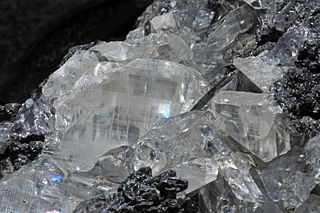
Anglesite is a lead sulfate mineral with the chemical formula PbSO4. It occurs as an oxidation product of primary lead sulfide ore, galena. Anglesite occurs as prismatic orthorhombic crystals and earthy masses, and is isomorphous with barite and celestine. It contains 74% of lead by mass and therefore has a high specific gravity of 6.3. Anglesite's color is white or gray with pale yellow streaks. It may be dark gray if impure.

Sylvite, or sylvine, is potassium chloride (KCl) in natural mineral form. It forms crystals in the isometric system very similar to normal rock salt, halite (NaCl). The two are, in fact, isomorphous. Sylvite is colorless to white with shades of yellow and red due to inclusions. It has a Mohs hardness of 2.5 and a specific gravity of 1.99. It has a refractive index of 1.4903. Sylvite has a salty taste with a distinct bitterness.

Thénardite is an anhydrous sodium sulfate mineral, Na2SO4 which occurs in arid evaporite environments, specifically lakes and playas. It also occurs in dry caves and old mine workings as an efflorescence and as a crusty sublimate deposit around fumaroles. It occurs in volcanic caves on Mount Etna, Italy. It was first described in 1825 for an occurrence in the Espartinas Saltworks, Ciempozuelos, Madrid, Spain and was named for the French chemist, Louis Jacques Thénard (1777–1826).

Valentinite is an antimony oxide mineral with formula Sb2O3. Valentinite crystallizes in the orthorhombic system and typically forms as radiating clusters of euhedral crystals or as fibrous masses. It is colorless to white with occasional shades or tints of yellow and red. It has a Mohs hardness of 2.5 to 3 and a specific gravity of 5.76. Valentinite occurs as a weathering product of stibnite and other antimony minerals. It is dimorphous with the isometric antimony oxide senarmontite.
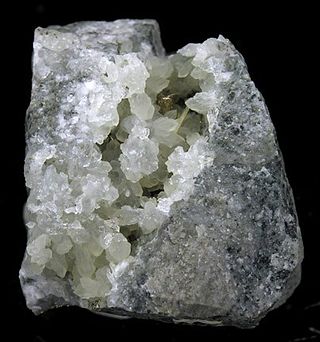
Krennerite is an orthorhombic gold telluride mineral which can contain variable amounts of silver in the structure. The formula is AuTe2, but specimen with gold substituted by up to 24% with silver have been found ([Au0.77Ag0.24]Te2). Both of the chemically similar gold-silver tellurides, calaverite and sylvanite, are in the monoclinic crystal system, whereas krennerite is orthorhombic.
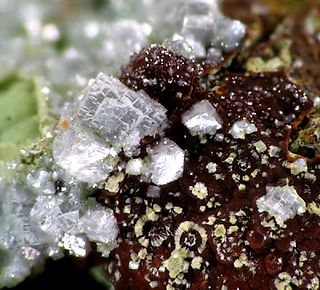
Otavite is a rare cadmium carbonate mineral with the formula CdCO3. Otavite crystallizes in the trigonal system and forms encrustations and small scalenohedral crystals that have a pearly to adamantine luster. The color is white to reddish to yellow brown. Its Mohs hardness is 3.5 to 4 and the specific gravity is 5.04. Associated minerals include azurite, calcite, malachite, and smithsonite.
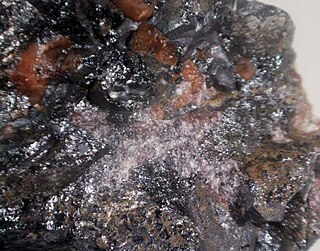
The rare mineral adelite, is a calcium, magnesium, arsenate with chemical formula CaMgAsO4OH. It forms a solid solution series with the vanadium-bearing mineral gottlobite. Various transition metals substitute for magnesium and lead replaces calcium leading to a variety of similar minerals in the adelite–duftite group.
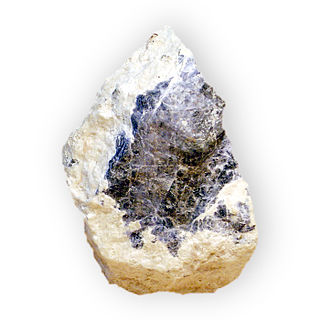
Cancrinite is a complex carbonate and silicate of sodium, calcium and aluminium with the formula Na6Ca2[(CO3)2|Al6Si6O24]·2H2O. It is classed as a member of the feldspathoid group of minerals; the alkali feldspars that are poor in silica. Yellow, orange, pink, white or even blue, it has a vitreous or pearly luster; a hardness of 5–6 and an uneven conchoidal fracture. It is unusual among the silicate minerals in that it will effervesce with hydrochloric acid due to the associated carbonate ions.

Hanksite is a sulfate mineral, distinguished as one of only a handful that contain both carbonate and sulfate ions (a sulfate carbonate). It has the chemical formula Na22K(SO4)9(CO3)2Cl.
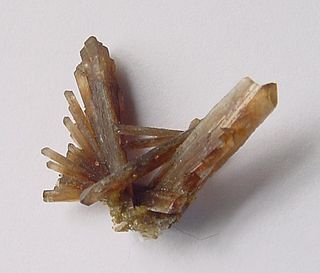
Childrenite is a rare hydrated phosphate mineral with elements iron, manganese, aluminium, phosphorus, oxygen and hydrogen. Its chemical formula is (Fe2+
,Mn)2+
AlPO
4(OH)
2•H
2O and it has a molecular weight of 229.83 g/mol. Its specific gravity is 3.2 and it has a Mohs hardness of 4.5 to 5. It is usually translucent and non-fluorescent, with imperfect cleavage. It has a vitreous lustre with a white streak, and is brown or yellow in color. It has a conchoidal, uneven fracture, and an orthorhombic crystal system.

Rutherfordine is a mineral containing almost pure uranyl carbonate (UO2CO3). It crystallizes in the orthorhombic system in translucent lathlike, elongated, commonly radiating in fibrous, and in pulverulent, earthy to very fine-grained dense masses. It has a specific gravity of 5.7 and exhibits two directions of cleavage. It appears as brownish, brownish yellow, white, light brown orange, or light yellow fluorescent encrustations. It is also known as diderichite.

Kermesite or antimony oxysulfide is also known as red antimony or purpur blende (Sb2S2O). The mineral's color ranges from cherry red to a dark red to a black. Kermesite is the result of partial oxidation between stibnite (Sb2S3) and other antimony oxides such as valentinite (Sb2O3) or stibiconite (Sb3O6(OH)). Under certain conditions with oxygenated fluids the transformation of all sulfur to oxygen would occur but kermesite occurs when that transformation is halted.
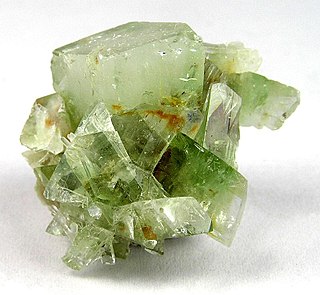
Augelite is an aluminium phosphate mineral with formula: Al2(PO4)(OH)3. The shade varies from colorless to white, yellow or rose. Its crystal system is monoclinic.

Ardaite is a very rare sulfosalt mineral with chemical formula Pb19Sb13S35Cl7 in the monoclinic crystal system, named after the Arda River, which passes through the type locality. It was discovered in 1978 and approved by the International Mineralogical Association in 1980. It was the second well-defined natural chlorosulfosalt, after dadsonite.
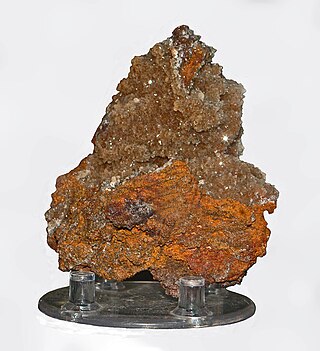
Tarbuttite is a rare phosphate mineral with formula Zn2(PO4)(OH). It was discovered in 1907 in what is now Zambia and named for Percy Coventry Tarbutt.
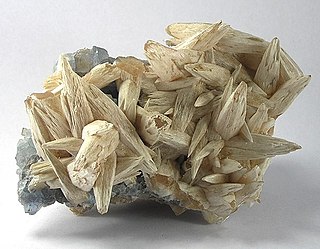
Benstonite is a mineral with formula Ba6Ca6Mg(CO3)13. Discovered in 1954, the mineral was described in 1961 and named after Orlando J. Benston (1901–1966).
Daubréeite is a rare bismuth oxohalide mineral with formula BiO(OH,Cl). It is a creamy-white to yellow-brown, soft, earthy clay–like mineral which crystallizes in the tetragonal crystal system. It is a member of the matlockite group.
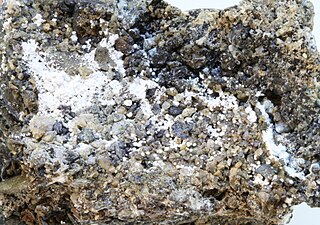
Felsőbányaite or basaluminite is a hydrated aluminium sulfate mineral with formula: Al4(SO4)(OH)10·4H2O. It is a rare white to pale yellow mineral which typically occurs as globular masses and incrustations or as minute rhombic crystals. It crystallizes in the monoclinic crystal system.



















